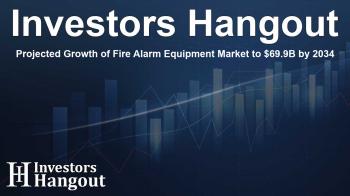Projected Growth of Fire Alarm Equipment Market to $69.9B by 2034

Overview of the Fire Alarm Equipment Market
The Fire Alarm Equipment Market is anticipated to experience significant growth in the coming years, with projections indicating it could reach a remarkable USD 69,862.2 million by 2034. This growth is driven by various factors, including increasing safety regulations, rising awareness regarding fire safety, and advancements in technology.
Current Market Trends
Based on recent research, the global fire alarm equipment market was valued at approximately USD 36,185.1 million in 2024. This figure is predicted to increase to around USD 38,645.7 million in 2025, indicating robust growth potential. The compound annual growth rate (CAGR) is expected to be about 6.8% during the forecast period of 2025 to 2034.
Driving Forces Behind Market Growth
Stringent Safety Regulations
Governments and regulatory bodies worldwide are implementing stricter fire safety regulations and building codes. This heightened regulation drives demand for sophisticated fire alarm systems in various settings, helping to ensure safety for occupants in commercial, industrial, and residential buildings.
Increased Fire Safety Awareness
There is a growing consciousness among individuals, companies, and authorities regarding the vital importance of fire safety measures. High-profile incidents and a focused approach toward preventive measures promote investments in fire alarm systems, fostering market expansion.
Technological Innovations
Technological advancements in fire alarm equipment, such as the development of smart systems and enhanced sensor technologies, are playing a pivotal role in market growth. These innovations not only boost reliability and efficiency but also align with the move towards automation and system integration.
Urbanization and Infrastructure Development
The rapid urbanization observed in several emerging economies is creating ample opportunities in the fire alarm equipment market. New construction endeavors—including commercial buildings and public infrastructure projects—necessitate state-of-the-art fire detection and alarm systems.
Focus on Asset Protection
The business landscape is increasingly valuing asset protection strategies, leading to surging demand for advanced fire alarm systems. Comprehensive fire safety solutions are critical for safeguarding infrastructure and minimizing financial losses caused by business interruptions.
Integration with Smart Technology
The rise in smart building technologies and IoT integration continues to influence the fire alarm equipment sector significantly. Creating centralized monitoring systems enhances operational efficiency and contributes to overall building safety.
Industry Partnerships and Innovations
Recent developments in the market include significant product introductions from key players. For instance, Honeywell released the Morley-IAS Max fire detection system, while Johnson Controls launched the FireClass range aimed at enhancing safety across various environments. These innovations underline the commitment of leading companies to enhance fire safety standards globally.
Market Segmentation
The fire alarm equipment market can be segmented into various categories:
By Product Type
- Smoke Detectors
- Heat Detectors
- Flame Detectors
- Manual Call Points
- Fire Alarm Panels
- Notification Devices
- Other Equipment
By Alarm Type
- Audible Alarms
- Visual Alarms
- Manual Call-point Alarms
By End-User Industry
- Construction
- Oil & Gas
- Healthcare
- BFSI (Banking, Financial Services, and Insurance)
- Hospitality
- Education
- Retail
- Manufacturing
- Transportation & Logistics
- Government
- Others
Impact of COVID-19 on the Market
The COVID-19 pandemic brought both challenges and opportunities for the fire alarm equipment market. While construction activities were disrupted initially, the shift towards increased workplace safety highlighted the need for advanced fire alarm systems. As businesses reopen and construction resumes, demand for fire safety products is expected to rebound, fostering market growth.
Frequently Asked Questions
What is the projected size of the fire alarm equipment market?
The market is projected to reach USD 69,862.2 million by 2034.
What are the key factors driving market growth?
Key factors include stringent safety regulations, increased awareness of fire safety, and advancements in technology.
How has COVID-19 impacted the fire alarm equipment market?
COVID-19 initially disrupted construction, but it simultaneously raised awareness of fire safety, leading to potential increased demand for these systems in the post-pandemic world.
What are the main segments of the market?
The market is segmented by product type, alarm type, and end-user industry.
Who are the major players in the fire alarm equipment market?
The major players include Honeywell International Inc., Johnson Controls, and Siemens AG, among others.
About The Author
Contact Lucas Young privately here. Or send an email with ATTN: Lucas Young as the subject to contact@investorshangout.com.
About Investors Hangout
Investors Hangout is a leading online stock forum for financial discussion and learning, offering a wide range of free tools and resources. It draws in traders of all levels, who exchange market knowledge, investigate trading tactics, and keep an eye on industry developments in real time. Featuring financial articles, stock message boards, quotes, charts, company profiles, and live news updates. Through cooperative learning and a wealth of informational resources, it helps users from novices creating their first portfolios to experts honing their techniques. Join Investors Hangout today: https://investorshangout.com/
The content of this article is based on factual, publicly available information and does not represent legal, financial, or investment advice. Investors Hangout does not offer financial advice, and the author is not a licensed financial advisor. Consult a qualified advisor before making any financial or investment decisions based on this article. This article should not be considered advice to purchase, sell, or hold any securities or other investments. If any of the material provided here is inaccurate, please contact us for corrections.

